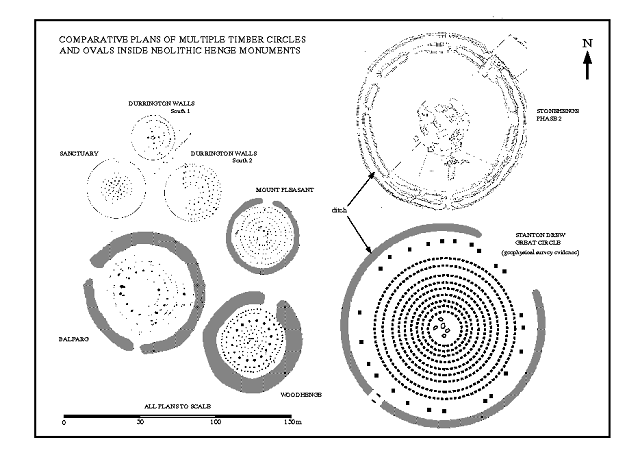Remarkable find at Stanton Drew
|
|
The site at Stanton Drew near Bristol is famous for its complex of stone circles, the
Great Circle being one of the largest in the country. But this year the Ancient
Monuments Laboratory of English Heritage carried out a geophysical survey with
astonishing results. At a stroke, they have demonstrated that the megalithic remains
are the ruin of a much more elaborate and important site. Lying under the pasture
within the Great Circle are the remains of a highly elaborate pattern of buried
pits. They are arranged in nine rings concentric with the stone circle, at the
centre of which are further pits. The rings of pits vary in diameter, from about 23m
to 95m, the pits being about a meter in diameter. Just as remarkable is the
discovery of a very large buried enclosure ditch (135m diameter by 7m wide).
Such enclosures, or henges, are a well-known Neolithic feature of Britain and are assumed
to be ritualistic in nature.

Sites, which bear the closest similarity, include Woodhenge near Stonehenge and the
Sanctuary near Avebury. At these and other sites, the pits are known to have held
massive timber uprights, although roofing of any kind is never evident. No excavations are
planned but further magnetic surveys may help to shed more light on this important henge
complex. This report is from the internet, if you want more details, contact me at
the meeting.
New Canal Society
A few years ago Mike Clark from Accrington gave us a talk on the Douglas Valley.
He has now sent me details of a new Society aimed at preserving, recording and improving
access to the Leeds & Liverpool Canal. The canal’s total length is 141
miles, making it the longest in the country, with well over 100 listed
structures, such as warehouses, cottages, bridges and wharfs along its length.
It was first proposed in 1765 and was completed and open throughout in 1816, (this
included the southern section of the Lancaster Canal which it gained control of in
1864). For 178 years it was a private company, becoming nationalised with the
majority of the country’s canals and railways, in 1948. During the nineteenth century
more than two million tons of merchandise were carried each year. The last regular
traffic ended in 1972 when coal deliveries from Bikershaw colliery to Wigan Power Station
ceased. If you are interested in joining the Society the subscription is £5 (£2.50
concessionary). Contact me at the meeting for an application form or write to Mr
Clark at 41 Fountain Street, Accrington BB5 0QR.
|



